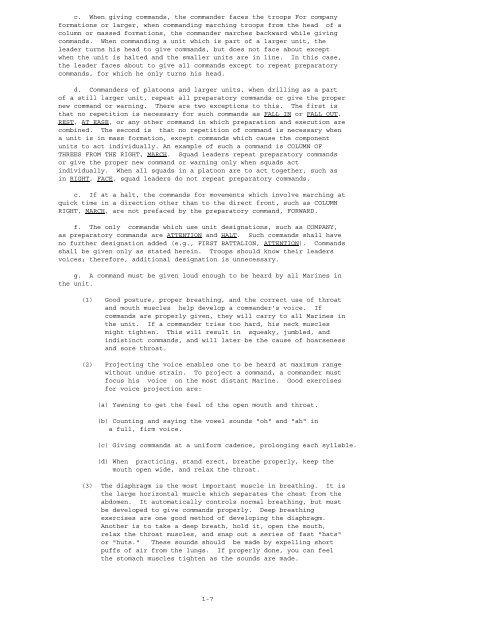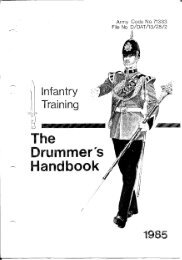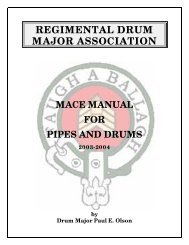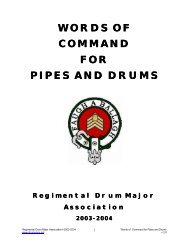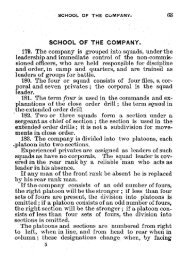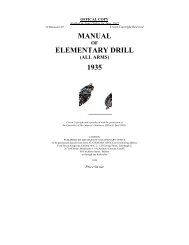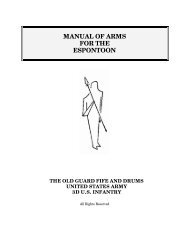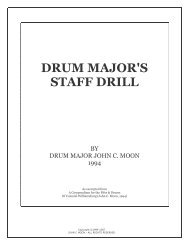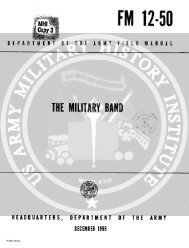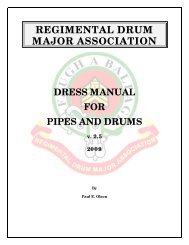Marine corps drill and ceremonies manual - Regimental Drum Major ...
Marine corps drill and ceremonies manual - Regimental Drum Major ...
Marine corps drill and ceremonies manual - Regimental Drum Major ...
You also want an ePaper? Increase the reach of your titles
YUMPU automatically turns print PDFs into web optimized ePapers that Google loves.
c. When giving comm<strong>and</strong>s, the comm<strong>and</strong>er faces the troops For company<br />
formations or larger, when comm<strong>and</strong>ing marching troops from the head of a<br />
column or massed formations, the comm<strong>and</strong>er marches backward while giving<br />
comm<strong>and</strong>s. When comm<strong>and</strong>ing a unit which is part of a larger unit, the<br />
leader turns his head to give comm<strong>and</strong>s, but does not face about except<br />
when the unit is halted <strong>and</strong> the smaller units are in line. In this case,<br />
the leader faces about to give all comm<strong>and</strong>s except to repeat preparatory<br />
comm<strong>and</strong>s, for which he only turns his head.<br />
d. Comm<strong>and</strong>ers of platoons <strong>and</strong> larger units, when <strong>drill</strong>ing as a part<br />
of a still larger unit, repeat all preparatory comm<strong>and</strong>s or give the proper<br />
new comm<strong>and</strong> or warning. There are two exceptions to this. The first is<br />
that no repetition is necessary for such comm<strong>and</strong>s as FALL IN or FALL OUT,<br />
REST, AT EASE, or any other comm<strong>and</strong> in which preparation <strong>and</strong> execution are<br />
combined. The second is that no repetition of comm<strong>and</strong> is necessary when<br />
a unit is in mass formation, except comm<strong>and</strong>s which cause the component<br />
units to act individually. An example of such a comm<strong>and</strong> is COLUMN OF<br />
THREES FROM THE RIGHT, MARCH. Squad leaders repeat preparatory comm<strong>and</strong>s<br />
or give the proper new comm<strong>and</strong> or warning only when squads act<br />
individually. When all squads in a platoon are to act together, such as<br />
in RIGHT, FACE, squad leaders do not repeat preparatory comm<strong>and</strong>s.<br />
c. If at a halt, the comm<strong>and</strong>s for movements which involve marching at<br />
quick time in a direction other than to the direct front, such as COLUMN<br />
RIGHT, MARCH, are not prefaced by the preparatory comm<strong>and</strong>, FORWARD.<br />
f. The only comm<strong>and</strong>s which use unit designations, such as COMPANY,<br />
as preparatory comm<strong>and</strong>s are ATTENTION <strong>and</strong> HALT. Such comm<strong>and</strong>s shall have<br />
no further designation added (e.g., FIRST BATTALION, ATTENTION). Comm<strong>and</strong>s<br />
shall be given only as stated herein. Troops should know their leaders<br />
voices; therefore, additional designation is unnecessary.<br />
g. A comm<strong>and</strong> must be given loud enough to be heard by all <strong>Marine</strong>s in<br />
the unit.<br />
(1) Good posture, proper breathing, <strong>and</strong> the correct use of throat<br />
<strong>and</strong> mouth muscles help develop a comm<strong>and</strong>er’s voice. If<br />
comm<strong>and</strong>s are properly given, they will carry to all <strong>Marine</strong>s in<br />
the unit. If a comm<strong>and</strong>er tries too hard, his neck muscles<br />
might tighten. This will result in squeaky, jumbled, <strong>and</strong><br />
indistinct comm<strong>and</strong>s, <strong>and</strong> will later be the cause of hoarseness<br />
<strong>and</strong> sore throat.<br />
(2) Projecting the voice enables one to be heard at maximum range<br />
without undue strain. To project a comm<strong>and</strong>, a comm<strong>and</strong>er must<br />
focus his voice on the most distant <strong>Marine</strong>. Good exercises<br />
for voice projection are:<br />
(a) Yawning to get the feel of the open mouth <strong>and</strong> throat.<br />
(b) Counting <strong>and</strong> saying the vowel sounds "oh" <strong>and</strong> "ah" in<br />
a full, firm voice.<br />
(c) Giving comm<strong>and</strong>s at a uniform cadence, prolonging each syllable.<br />
(d) When practicing, st<strong>and</strong> erect, breathe properly, keep the<br />
mouth open wide, <strong>and</strong> relax the throat.<br />
(3) The diaphragm is the most important muscle in breathing. It is<br />
the large horizontal muscle which separates the chest from the<br />
abdomen. It automatically controls normal breathing, but must<br />
be developed to give comm<strong>and</strong>s properly. Deep breathing<br />
exercises are one good method of developing the diaphragm.<br />
Another is to take a deep breath, hold it, open the mouth,<br />
relax the throat muscles, <strong>and</strong> snap out a series of fast "hats"<br />
or "huts." These sounds should be made by expelling short<br />
puffs of air from the lungs. If properly done, you can feel<br />
the stomach muscles tighten as the sounds are made.<br />
1-7


